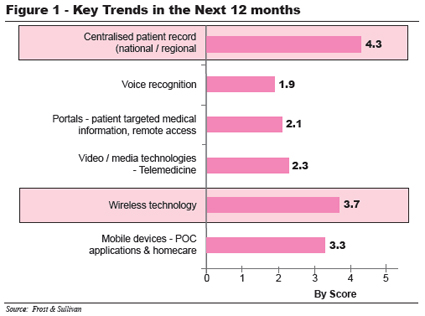 Frost & Sullivan research determines that specifically two technologies that are likely to emerge ahead in adoption by healthcare organisations are wireless communications and centralized patient records. The delivery of healthcare is increasingly mobile. Improvements in wireless communication system and devices will further facilitate expanded use of this technology. Furthermore, increasing demand of efficient patient care, accessibility of data across various departments and patient safety is going to grow the adoption of centralized pnike sb
Frost & Sullivan research determines that specifically two technologies that are likely to emerge ahead in adoption by healthcare organisations are wireless communications and centralized patient records. The delivery of healthcare is increasingly mobile. Improvements in wireless communication system and devices will further facilitate expanded use of this technology. Furthermore, increasing demand of efficient patient care, accessibility of data across various departments and patient safety is going to grow the adoption of centralized pnike sbHealthcare Information Technology: Changing Patient Care Scenario
Source: Release Date:2009-12-08 270
One of the most critical factors to successful organizational and business performance is the ability to manage accessibility and processing of information. Accurate, timely, and relevant data form the basis for planning, monitoring, and decision making process across the organization. Healthcare, more than other industries, feels the pinch of dealing with substandard and inaccurate information because it is more data rich, data dependent and data sensitive than any other sectors of economy. The practice of medicine requires continuous availability across the various functions to ensure best care outcome as well as perpetual state of readiness for possible changes with patient demands, competitive scenario, regulations, or disease patterns and new outbreaks. Healthcare information technology (HIT) forms a pivotal part of today's healthcare system. Improved quality of healthcare, patient safety, drastic reduction in medical errors and enhancement of care delivery has been made possible because of induction of these solutions in the healthcare delivery environment. Today, healthcare IT solutions are enabling processes like planning, decision making related to organizational development, strategic planning to drive growth, recruitment of competent personnel, managing employee benefits, payroll, intradepartment communication etc. Back office solutions like finance & accounting, resource utilization, asset management are inducing optimal efficiency in healthcare delivery using IT. Even the marketing aspects of healthcare delivery organizations are improvised by various customer relationship management solutions. As number of patients and costs rise, the need for better utilization of resources, maintaining inventory and keeping variable costs as low as possible. This has been taken cared of by excellent material and asset management modules. Furthermore, it is established that healthcare IT is slowly moving from its traditional administrative function emphasis to a more clinical focus and eventually offer a scenario of an integrated delivery network. Adoption of clinical systems has lead to a situation wherein efficient medication management could be possible. Availability of medical records and clinical decision support systems has taken healthcare delivery to new heights. Today, patients are given ability to self杕anage disease and avail remote consultation and monitoring. Self-testing, early treatment, and the management of medication of chronic diseases and mental health enable prevention of potential ailments along with increasing longevity of life span. Furthermore, emphasis is given on home healthcare services to improve hospital efficiencies and save patient costs. IT is making all this possible. It Is All About Technology Technology will continue to improve and will offer new opportunities for healthcare organizations during the coming years. The overall trend in the industry is to keep the healthcare consumer as the center of focus. One promising application development and implementation approach i.e. service oriented architecture is enabling the integration of legacy investments, improving business agility, and overall cost efficiency. Another growing trend is the use of the power of the Web and Web browsers to provide access to clinical information to clinicians based outside the hospital environment.  Frost & Sullivan research determines that specifically two technologies that are likely to emerge ahead in adoption by healthcare organisations are wireless communications and centralized patient records. The delivery of healthcare is increasingly mobile. Improvements in wireless communication system and devices will further facilitate expanded use of this technology. Furthermore, increasing demand of efficient patient care, accessibility of data across various departments and patient safety is going to grow the adoption of centralized pnike sb
Frost & Sullivan research determines that specifically two technologies that are likely to emerge ahead in adoption by healthcare organisations are wireless communications and centralized patient records. The delivery of healthcare is increasingly mobile. Improvements in wireless communication system and devices will further facilitate expanded use of this technology. Furthermore, increasing demand of efficient patient care, accessibility of data across various departments and patient safety is going to grow the adoption of centralized pnike sb
 Frost & Sullivan research determines that specifically two technologies that are likely to emerge ahead in adoption by healthcare organisations are wireless communications and centralized patient records. The delivery of healthcare is increasingly mobile. Improvements in wireless communication system and devices will further facilitate expanded use of this technology. Furthermore, increasing demand of efficient patient care, accessibility of data across various departments and patient safety is going to grow the adoption of centralized pnike sb
Frost & Sullivan research determines that specifically two technologies that are likely to emerge ahead in adoption by healthcare organisations are wireless communications and centralized patient records. The delivery of healthcare is increasingly mobile. Improvements in wireless communication system and devices will further facilitate expanded use of this technology. Furthermore, increasing demand of efficient patient care, accessibility of data across various departments and patient safety is going to grow the adoption of centralized pnike sb
You May Like

 iConnectHub
iConnectHub
 Login/Register
Login/Register Supplier Login
Supplier Login


























